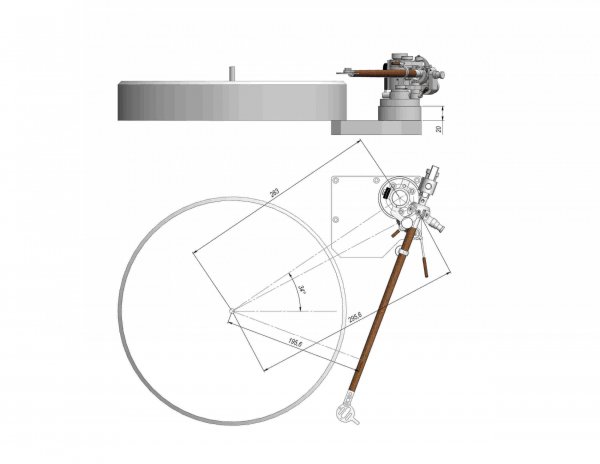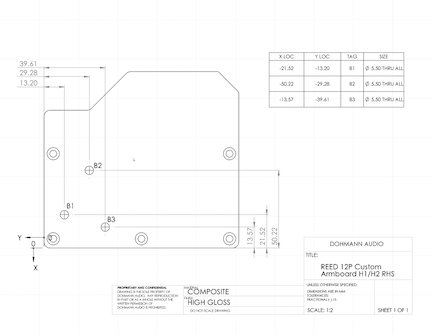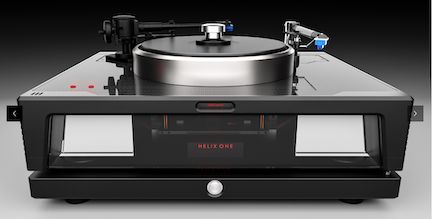I feel worse about this than I have after attending some funerals. After 30 plus years, I am retiring my much beloved Goldmund Studio turntable with a Goldmund T3F tonearm. If I had a dollar for every time this turntable made my brain sing, I would be a wealthy man. I can however, attest to the fact that I found great comfort in benefiting from riches in lieu of dollars for all the joy that table provided over several decades of use.
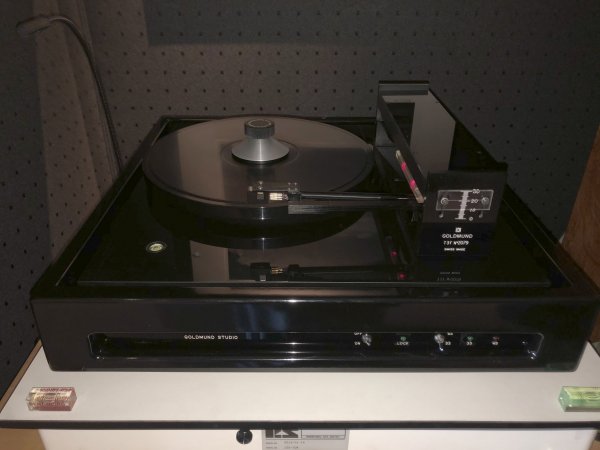
I, along with almost every audiophile at the time, coveted the Goldmund Reference that for lack of a better descriptor, Harry Pearson put on the map in the late 80’s. At the time, I certainly could not afford a Goldmund Reference, but broke the piggy bank to buy a Goldmund Studio and one of the latest versions of the famed T3F arm which was a demo piece from a well-known dealer in Philly. The Studio and T3 arm (originally a T3B) was actually first made in 1981, well before Goldmund introduced their Reference Table in 1986. Although the Studio was not the Reference, its sound quality was, and still is, superb by any standard. Its sheer musicality is outstanding and never gets in the way of listening. Its midrange is about as good as it gets, and when set-up properly, has unbelievable dynamics, transparency, slam, and excellent bass. The key is that “set-up” is a bitch and then some. There are more tricks to setting this thing up than Carter’s has liver pills, and applying the full measure of these tricks took the better part of those 30 years to navigate. The good news, is that I think I’ve finally mastered it!! (As one of my patients once told me, his daddy’s favorite expression about him was “he may not be smart, but he sure is slow”. I can relate.) We all know everything matters in audio, but the Studio/T3F pushed me to my limits. The miniscule requisite forward angle of the tonearm carriage; the tracking force which cannot be adjusted with a fine tuning knob but rather with big clunky weights; the cartridge azimuth which must be adjusted with head shell shims as there is no azimuth adjustment on the arm; the VTA which requires miniscule adjustments of surgical precision to get right; the optimal rotation and position of the springs under the platter; and last but not least, the damn silicon damping fluid trough (which requires optimum levels with +/- 10uL using a lab pipette) comprise many of the mind-numbing hurdles one has to clear to get this thing to perform it’s best. But when it does, it’s a delight indeed. I’ve used several cartridges but for most of its life, Benz cartridges have served me well, going way back to a Benz MC-3 that Dave Wilson was quite fond of, then to a Ruby, and Ruby 2 and culminating in a Benz LPS currently. For all the cursing I did in setting the table up in all its iterations over 30+ years, it is the joy of making music with it that I will always remember fondly. I really love this thing and will truly be sad to see it go.
I’ve paired the TT with a long list of preamps and phono stages covering the usual suspects (ARC, VTL, Krell, etc.), but my current Zanden 1200 MkIII is the current cat’s meow and is more than ready to welcome its new replacement which is this:
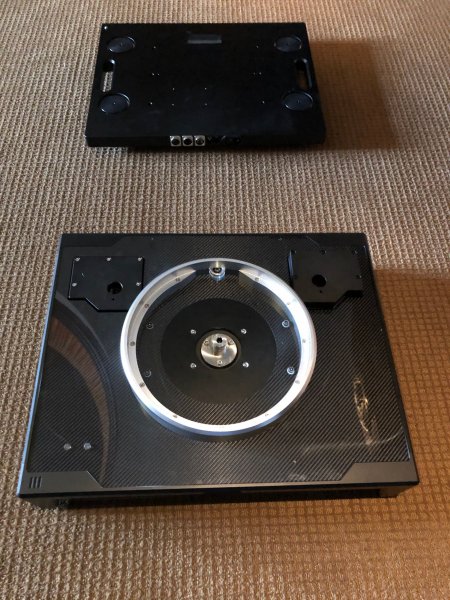
https://dohmannaudio.com/helix-one/
The acquisition of the Dohmann Helix 1 Mk II has more twists and plot turns than an Agatha Christie novel. It was actually the 3rd table I made an offer for, having failed at buying a Kodo Beat SE and a Wave Kinetics NVS after making offers that I thought were accepted only to be withdrawn in the 11th hour. I initially hesitated on making an offer for the Dohmann because I presumed it was unobtainable at the asking price, but desperation is a funny thing. I had nothing to lose except my pride so I made an offer that was fortunately, ultimately accepted.
More on this potentially outstanding table when it completes its first round of set-up and listening. Although my Goldmund has been the one piece of audio gear I owned for the longest time, every cloud does indeed have a silver lining and the Dohmann looks like it could genuinely be a very nice ray of sunshine as it undertakes its new role as the last TT I will likely ever own. We shall soon see.

I, along with almost every audiophile at the time, coveted the Goldmund Reference that for lack of a better descriptor, Harry Pearson put on the map in the late 80’s. At the time, I certainly could not afford a Goldmund Reference, but broke the piggy bank to buy a Goldmund Studio and one of the latest versions of the famed T3F arm which was a demo piece from a well-known dealer in Philly. The Studio and T3 arm (originally a T3B) was actually first made in 1981, well before Goldmund introduced their Reference Table in 1986. Although the Studio was not the Reference, its sound quality was, and still is, superb by any standard. Its sheer musicality is outstanding and never gets in the way of listening. Its midrange is about as good as it gets, and when set-up properly, has unbelievable dynamics, transparency, slam, and excellent bass. The key is that “set-up” is a bitch and then some. There are more tricks to setting this thing up than Carter’s has liver pills, and applying the full measure of these tricks took the better part of those 30 years to navigate. The good news, is that I think I’ve finally mastered it!! (As one of my patients once told me, his daddy’s favorite expression about him was “he may not be smart, but he sure is slow”. I can relate.) We all know everything matters in audio, but the Studio/T3F pushed me to my limits. The miniscule requisite forward angle of the tonearm carriage; the tracking force which cannot be adjusted with a fine tuning knob but rather with big clunky weights; the cartridge azimuth which must be adjusted with head shell shims as there is no azimuth adjustment on the arm; the VTA which requires miniscule adjustments of surgical precision to get right; the optimal rotation and position of the springs under the platter; and last but not least, the damn silicon damping fluid trough (which requires optimum levels with +/- 10uL using a lab pipette) comprise many of the mind-numbing hurdles one has to clear to get this thing to perform it’s best. But when it does, it’s a delight indeed. I’ve used several cartridges but for most of its life, Benz cartridges have served me well, going way back to a Benz MC-3 that Dave Wilson was quite fond of, then to a Ruby, and Ruby 2 and culminating in a Benz LPS currently. For all the cursing I did in setting the table up in all its iterations over 30+ years, it is the joy of making music with it that I will always remember fondly. I really love this thing and will truly be sad to see it go.
I’ve paired the TT with a long list of preamps and phono stages covering the usual suspects (ARC, VTL, Krell, etc.), but my current Zanden 1200 MkIII is the current cat’s meow and is more than ready to welcome its new replacement which is this:

https://dohmannaudio.com/helix-one/
The acquisition of the Dohmann Helix 1 Mk II has more twists and plot turns than an Agatha Christie novel. It was actually the 3rd table I made an offer for, having failed at buying a Kodo Beat SE and a Wave Kinetics NVS after making offers that I thought were accepted only to be withdrawn in the 11th hour. I initially hesitated on making an offer for the Dohmann because I presumed it was unobtainable at the asking price, but desperation is a funny thing. I had nothing to lose except my pride so I made an offer that was fortunately, ultimately accepted.
More on this potentially outstanding table when it completes its first round of set-up and listening. Although my Goldmund has been the one piece of audio gear I owned for the longest time, every cloud does indeed have a silver lining and the Dohmann looks like it could genuinely be a very nice ray of sunshine as it undertakes its new role as the last TT I will likely ever own. We shall soon see.
Last edited:







